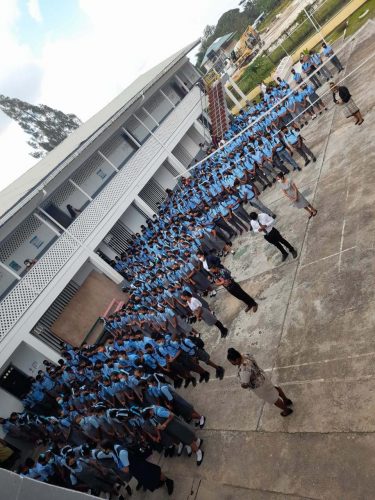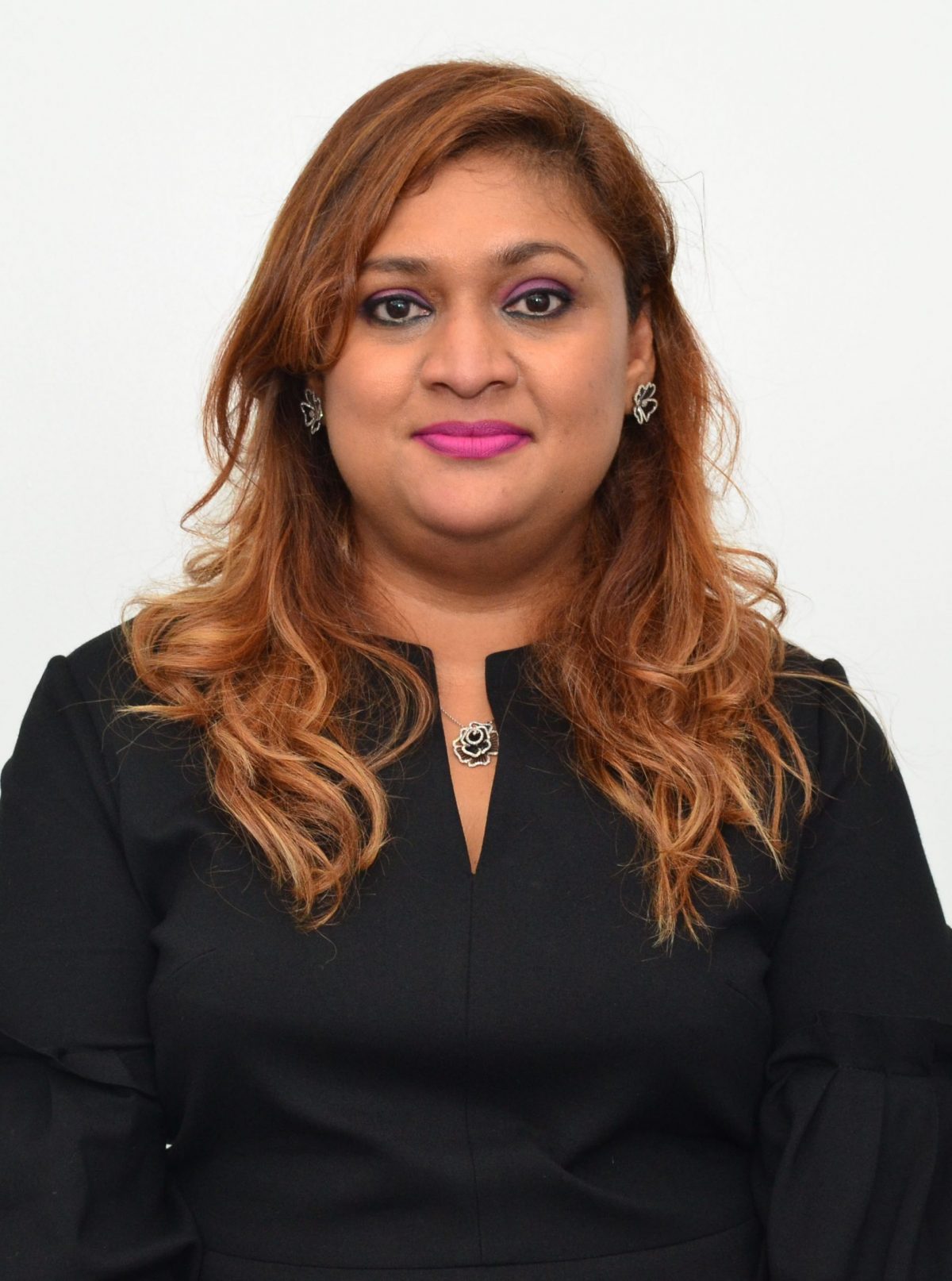Amesha La Rose, a fifth form student of St Ignatius Secondary, Region Nine, is happy to be back in the classroom despite the current anxiety about rising COVID-19 cases across the country.
Although La Rose acknowledges that there are dangers with the number of COVID-19 cases rising, suspected to be driven by the presence of the Omicron variant of the virus, she said that the students have already had to skip a year of learning and without returning to the classrooms they might never catch up.

“Personally I am happy that school reopened because in the online classes, students were not really focusing,” the teenager said. She explained that it was difficult to be in online classes with connectivity issues in the hinterland region.
La Rose also said that the students were behind and she fears that the 2022 batch of students might not be as successful at the upcoming Caribbean Secondary Education Certificate examinations as those from previous years because they are behind. She said that the teachers are trying their best but the learning loss simply can’t be overlooked.
Additionally, she said some students were becoming unmotivated and discouraged, with some even dropping out or for other reasons no longer attending classes.
Another student, Kevianna Forde, of St. Ignatius Secondary, is also happy to be back in the classroom. Like La Rose, Forde said that it was difficult to be a part of online classes when the schools were closed as she complained that there was bad internet connection.
Forde is not too worried about transmission of the virus in class because she has observed that her classmates wear their masks and have been social distancing. However, another student, Shani Narain, said that she worries about the lack of sanitizers in the classroom. She said that students were provided with personal sanitizers at the beginning of school year but within two weeks that was done. Although she noted that the schools have the wash stations for hand washing and the guards have sanitizers, she recommended constant distribution of sanitizers to students. She added that she has also observed that some students do not follow safety protocols in the classrooms.
Saying that students have suffered significant learning loss due to the closure of schools for an 18-month period, the Education Ministry reopened schools for the secondary, primary and nursery levels for the current Easter term on January 3.
For the Easter term, the ministry has indicated that all secondary school students will attend school every day while Grade Seven students as well as those in primary and nursery levels will rotate between online and in person classes.
However, the new year has seen a spate of COVID-19 cases within schools since the reopening and this has led to several institutions to resort to online teaching.
With the recent surge of cases, the Guyana Teachers’ Union (GTU) has called for a two-week closure of schools to assess the situation. The union wrote to the ministry and urged that teachers deliver lessons virtually while the schools are closed to face-to-face engagement.
In pressing its case, the GTU reported that 105 teachers tested positive during the five days that schools were reopened, resulting in the forced closure of 15 schools.
Despite the GTU’s position, Education Minister Priya Manickchand has said that schools will remain open to face to face learning.
Not new
Manickchand told this newspaper that teachers and students who tested positive for COVID-19 were either infected prior to or during the first day and that these were also detected during the initial reopening of schools.
“From the moment we opened schools in 2020, from then to now, there have been schools that have been closed and reopened and some of them closed again. Teachers positive and students positive. People got to get tested. That’s just how the school community has been from the time we reopened. This is not new at all. This has not been smooth sailing,” she said.
“If we know the science of Delta or Omicron, you can’t get a positive on Wednesday from something you catch on Wednesday. They had to have caught it five to 14 days before. If we are saying we are to close the schools for two weeks, we have to be closing, for two weeks, everything else that teachers do to have completely non-infected teachers two weeks from now,” she further argued.
She said that among the schools that have closed is the Bishops’ High, which had 11 teachers who either tested positive or had symptoms of COVID-19 when the school reopened. “So they either came in positive or fell positive on the first day. So they closed so that they can give them a chance to go get tested,” she said.
Manickchand also said that several schools have decided to engage through online means while waiting for the teachers and students in quarantine or isolation since the start of the term. She explained that schools choosing to use online platforms was always an option and the schools were allowed to decide how to engage their classrooms.
At Queen’s College, the students and teachers of Fifth and Sixth forms had to quarantine after they returned to school and a student later tested positive. Another school that opted for online platforms is St Stanislaus College, which has the Brickdam Police Station in the compound. She said that arrangements are being made to have the place fumigated.
As it relates to vaccination for both teachers and students, the minister said that the number of teachers vaccinated can be reflected in accordance with the number of persons vaccinated for each region. Previously it was reported that more than 70 per cent of the teachers in Region Four at the nursery and primary levels were vaccinated. She said that this remains and that data is being collected. She also said that Regions Eight and Ten continue to lag while the other regions have slightly higher percentages in comparison. Meanwhile, just over 42 per cent of the students have gotten their shots. She said that this data is not necessarily representing the students in the school system as some have either dropped out or have graduated and started working.
When the teachers are away
The failure of students to follow the safety protocol is a worry for parents. Sonia Henry, a parent from Mora, Essequibo River, said that when the teachers aren’t in the class, the students are not social distancing. She said that having students close to each other puts them in danger of either contracting or transmitting the virus.
Maggie Savory, a parent, who has a child at a secondary school and the other at a primary schools, said that she has taken it upon herself to constantly remind her children about the importance of face masks and sanitizing. She said that her children haven’t complained about any issues at school but she said that she thinks it is worrying to have them in school. Both parents said that there have been rumours of COVID-19 cases in the school but that they had not been confirmed. However, the rumours caused some parents to stop sending their children to school for a short period.
A mother of two from Wellington Park, in Berbice, said that she understands what the ministry is doing but she worries about the safety of having her children travel from their home to their schools. “I am living all the way in Wellington Park. One of my daughters goes to school in Rose Hall and one goes to school in Manchester. That means they will have to be travelling to and fro. Now the teachers say they are doing their best to keep the children separated. My daughter at Chandisingh, she said they sit one in a seat. The other one, I went to the school. I saw they are sitting two in a bench. My concern is the teachers are doing their best in school to see that everything is going according to protocol but what happens when they have to take vehicles on the road. Now they are children. They don’t know who they are interacting with on the road. Who vehicle they are taking,” the concerned parent said.
She explained that public transportation has many different persons and people do not know who is infected and who isn’t. She said not all children will constantly remember to sanitize and change their masks. This parent said that she was in support of the GTU’s request because she believes the schools needed that time to assess the surge of cases.
A teacher from Santa Rosa, in Region One, who asked not to be named, said that there is clustering at Santa Rosa Secondary, in violation of COVID-19 social distancing protocol. According to the teacher, in some instances, there are two classes occupying one classroom. In addition, there isn’t frequent sanitizing at the school, the teacher complained. She said that while there is poor internet connectivity in the area and parents find it hard to keep up with online work, there needs to be a system in place to ensure students, teachers and the parents are safe and return to school with ease. She recommended that a rotation system is re-implemented at the secondary levels.
A teacher at the JC Chandisingh Secondary, in Berbice, complained that not every student is turning out to classes and the teachers cannot teach half of the class and leave the other half out. Further, the teacher also highlighted poor ventilation and accommodation at the school. The teacher said that at the school auditorium, there are several classes close to each other and this makes teaching difficult because the students cannot hear over the other classes.






